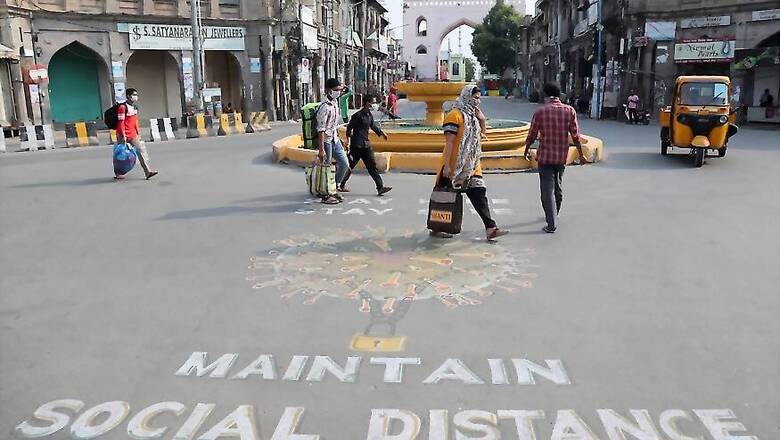
views
As lockdown 4.0, which was imposed to curb the spread of novel coronavirus in the country, ended on May 31, the central government on Saturday announced its plans for a phased reopening of the economy, dubbed as 'Unlock 1'.
The Ministry of Home Affairs (MHA) said that while the lockdown will continue to be in place in containment zones till June 30, certain activities will be permitted with effect from June 8 in the first phase of the lockdown exit strategy.
In Phase 1, places of worship, hotels, restaurants, and other hospitality services, and shopping mall will be allowed to reopen with advised precautions.
It has been planned to reopen educational institutions in Phase 2, a decision on which will be taken in July.
Similarly, international air travel for passengers, metro rail services, cinema halls, swimming pools, entertainment parks, gymnasiums, theatres, bars, auditoriums, and assembly halls will be reopened in Phase 3.
Apart from this, while night curfew will remain in place between 9pm to 5am, except for essential activities, states have been allowed to impose suitable restrictions, if deemed necessary.
Most countries that scrambled to put strict nationwide lockdowns to contain the spread of Covid-19 are resorting to gradual reopening in order to avoid sharp spikes in infections that could potentially undo the progress made during the lockdowns.
The United States
The US is the worst-affected country across the globe with 17.75 lakh confirmed Covid-19 cases and nearly 1,04, 000 deaths. Most states had been put under some form of lockdown in late March.
The growth of cases has varied across states and so has the response as well as the reopening strategy.
A majority of states, which began permitting limited activities in early May, have moved for quicker reopening unlike states like New York – the epicentre of the outbreak within the US – which has opted for a more conservative and cautious approach for the exit.
Houses of worship, personal care outlets such as hair salons and retail stores have been allowed to reopen in most of the states. Other non-essential businesses have been allowed to reopen as well in certain states at full capacity, while at least 35 states have allowed restaurant dining and reopening of bars.
In New York, Governor Andrew M. Cuomo has followed a 7-metric approach for a phased regional reopening in the state. These metrics include a 14-day decline in net hospitalisations and deaths, availability of beds and ICU beds, and a testing target. It’s only when all the seven parameters are met a county is cleared for reopening.
As of Sunday, most regions within the state have entered Phase 2 of reopening, in which personal care outlets will be allowed to reopen along with non-essential construction and manufacturing, and curb side pickup in restaurants and retail stores. Advisories, however, have been issued with regards to the number of employees allowed to work and adherence to social distancing norms.
New York City, the worst-affected zone within the state, is still under lockdown and is expected to enter Phase 1 of reopening on June 8.
Spain
In late April, Prime Minister Pedro Sánchez laid out a lockdown exit strategy consisting of four phases from Phase 0 to 3 with each one lasting for two weeks.
Phase 0, which allowed limited outside activities, was planned as a foundation for the transition.
Under Phase 1, small businesses were permitted to reopen with precautions such as earmarking specific shopping hours for those over 65 years old. Assemblies of up to 10 people were allowed as well.
Hotels were also allowed to reopen but with specific restrictions on access to common areas and adherence to social distancing.
In Phase 2, restaurants were planned to be reopened for interior dining. Similarly, cinemas and theatres were allowed to reopen with limited capacity.
The government also allowed assemblies of up to 50 people in closed spaces and up to 400 people in open spaces.
In Phase 3, beginning in the second week of June, all businesses will be allowed to restart with limited restrictions.
Spain has recorded 2.39 lakh confirmed cases of Covid-19 and over 27,000 deaths.
Germany
The federal government in Germany has left it on states to decide on reopening. The guidelines state that the lockdown will have to be imposed again if cases see a spike in a particular region.
People have been told to continue to practice social distancing. People have been allowed to meet each other, however, the limit on the number varies across states.
Professional football was allowed to resume in mid-May.
Shops and small businesses have been allowed to reopen as well with regulations on capacity and hygiene.
In the case of educational institutions, younger children, graduating classes, and students taking exams were allowed to return to schools.
Germany has witnessed more than 1,83, 000 confirmed cases of Covid-19 and over 8,500 deaths.
Italy
After a relative containment of the spread of the virus, Italy moved to ease lockdown restriction beginning in early May.
According to measures laid out by Prime Minister Giuseppe Conte, Italy allowed construction, parks, and manufacturing to reopen on May 4, while also allowing people to visit their relatives in limited numbers.
It permitted people to move around within regions, individual athletes to resume training and resumption of takeaway services in restaurants from May 4 onwards.
Retail shops, libraries, and museums were allowed to reopen on May 18.
Hair salons, bars, dine-in services in restaurants, and travel between regions will also be allowed starting from this week.
Restaurants, however, will be required to reduce the number of diners, place tables at a distance, and put plastic sheets to separate diners.
Italy was one of the first nations outside of China to report a massive outbreak of the novel coronavirus in March this year. It has recorded 2,33,000 confirmed cases and over 33,000 deaths.
The United Kingdom
The UK is the worst-affected European country with 2,76,000 confirmed cases and over 38,000 total deaths. Accepting the fact that the fight against the virus is going to continue for a long time, Prime Minister Boris Johnson in early May announced a detailed reopening plan for the nation.
People were allowed to go outdoors for sun-bathing, picnic, and meetings in small groups while maintaining social distance. If possible, employees were told to work from home. If they had to go to the office, they were advised to take private means of transport to avoid overcrowding in trains and buses.
Service providers such as cleaners and plumbers were also allowed to return to work except in homes where a patient is in isolation.
Educational institutions and all non-essential retail shops are expected to open by mid-June if social distancing is ensured in such places.
Restaurants, hair salons, hotels, cinemas and places of worship are expected to open in July.
Scotland and Wales with their own national government will be more conservative in their reopening plans than England, as it has been indicated by their leaders.
France
In France, restrictions first began to ease in mid-May. The country is set to enter Phase 2 of reopening beginning on June 2.
Primary schools and nurseries were allowed to reopen after in the second week of May and schools for older kids were permitted to reopen in green zones on May 18. Though, a limit of 15 students per classroom was imposed and masks were made compulsory.
Gatherings of small groups of people have also been allowed.
Restaurants, cafes, and bars will be allowed to open from Tuesday with restrictions. According to the order, tables in these places must be placed at least three feet apart and masks will be compulsory for both the employees and diners.
If the cases remain under control after these measures, the country is expected to reopen cinemas, gyms, and swimming pools by the end of June.
As India moves to ease its lockdown norms, one key difference that it has with other countries is that while countries such as in Europe and several states in the US eased restrictions after the daily increase in cases either contracted or stabilised.
However, in India’s case, the easing of the lockdown comes at a time when daily reported cases have risen consistently over the past couple of weeks.




















Comments
0 comment